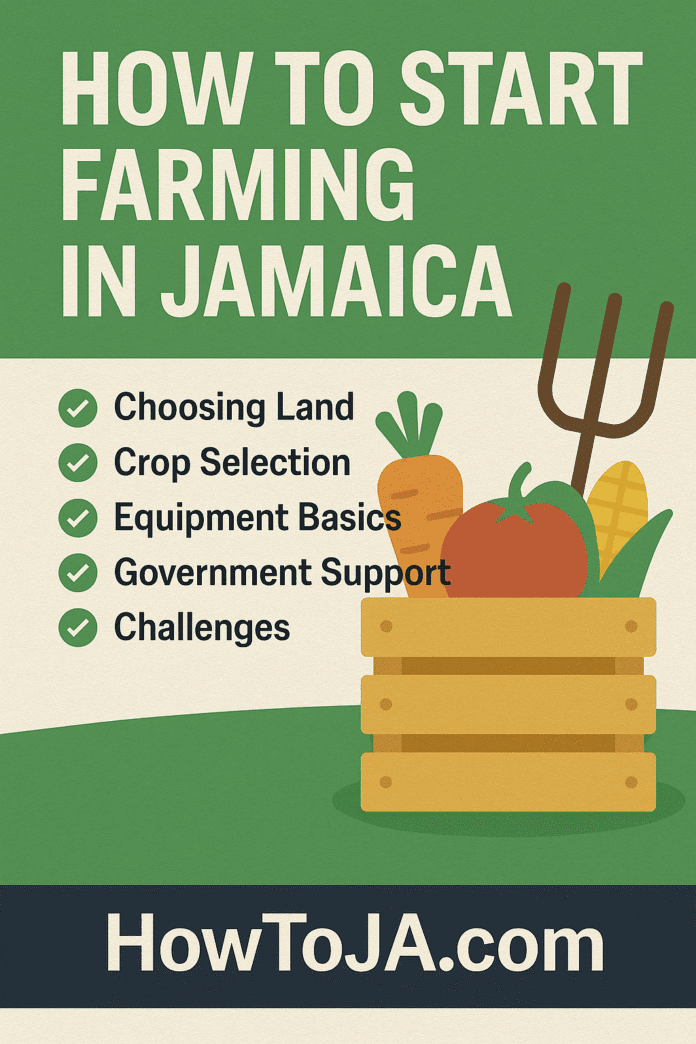Thinking about getting into farming in Jamaica? Whether you want to grow food for your family or start a small business, this beginner-friendly guide will show you how to start farming in Jamaica — step-by-step. 🇯🇲🌽
🌱 Step 1: Choose the Right Land
Your land choice can make or break your farm. Look for land that has:
- Good soil quality (avoid too much clay or sand)
- Water source nearby (stream, pipe, or rainwater system)
- Access by road or path for moving supplies
- Security (to protect your crops and tools)
Many first-time farmers start with ¼ to 1 acre and expand as they learn. Popular areas for farming include St. Elizabeth, Clarendon, and St. Ann.
🌾 Step 2: Choose the Right Crops
Pick crops based on your land, market demand, and how much work you can handle. Here are good options to start with:
- Callaloo, cabbage, pak choi – Fast-growing and easy to sell
- Scallion, thyme, hot pepper – High in demand, especially for seasoning
- Sorrel, watermelon, sweet potato – Seasonal crops that sell well
Start small with 1–2 crops so you don’t get overwhelmed. Visit Coronation Market or talk to vendors to learn what sells.
🛠️ Step 3: Basic Farming Tools and Equipment
You don’t need fancy machines to begin. Here are the essentials for beginners:
- Cutlass or machete
- Hoe and garden fork
- Water drums or buckets
- Fertilizer and seed trays
- Gloves, boots, and shade hat
As you grow, you can invest in irrigation systems, wheelbarrows, or small tillers to save time.
🤝 Step 4: Use Government Support Programs
The Jamaican government offers real help to small farmers. Here are some options you should know about:
1. Rural Agricultural Development Authority (RADA)
- Offers free training and farm visits
- Helps with pest control, crop planning, and records
- rada.gov.jm
2. Jamaica Agricultural Society (JAS)
- Gives access to farming groups and advice
- Offers events like Denbigh Agricultural Show
3. Grants and Loans
- Agro-Invest Corporation – Helps farmers get land and grow agribusiness
- EXIM Bank & Development Bank of Jamaica – Special loan programs for farmers
⚠️ Common Challenges (And How to Avoid Them)
- Lack of Water: Set up rain tanks or drip irrigation early
- Pests and Diseases: Work with RADA or use organic sprays
- Crop Theft: Fence your farm and harvest early
- Market Issues: Don’t overplant; talk to vendors or hotels before planting
✅ Quick Tips for Beginner Farmers
- Keep a farm notebook to track planting and harvest dates
- Try to save seeds from your best plants for next season
- Watch YouTube videos from local farmers for tips and motivation
- Start small and learn as you go — don’t try to do everything at once
🙋 Frequently Asked Questions
1. How much money do I need to start?
You can start with as little as JMD $10,000–$20,000 if you already have land. Focus on low-cost crops like callaloo or pepper.
2. Can I farm part-time?
Yes! Many farmers work in the early morning or evenings and grow crops that don’t need daily attention.
3. Where can I buy seeds and tools?
Check your local farm store, Agri-Supplies, or RADA office. You can also try online farm supply shops.
4. Do I need a license to sell produce?
Not for most roadside sales or markets. But if you plan to export or sell to big supermarkets, registration may be needed.
📌 Conclusion
Farming in Jamaica can be a rewarding side hustle or full-time living. With the right land, crop, and support, you can start small and grow strong. Don’t wait — plant something today and watch your future grow.
For more real-life how-to guides, visit the Everyday Life section of HowToJA.com.





